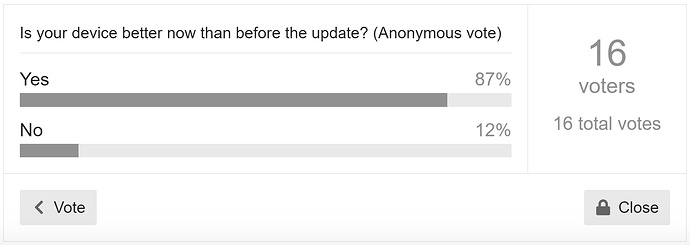These are the steps I took to take measurements. Downloaded dhry, and installed taskset through entware.
CoreELEC:~/downloads # installentware
CoreELEC:~/downloads # opkg install taskset
To measure the A53 and A73 clusters (1000000000 runs)
Stop Kodi
CoreELEC:~/downloads # systemctl stop kodi
Test A53 core
CoreELEC:~/downloads # taskset -c 0 ./dhry
Test A73 core
CoreELEC:~/downloads # taskset -c 2 ./dhry
s922z (2nd gen Cube)
A53 calculation
8689607.0 dhrystones per second / 1757 (fixed scaling factor) = 4945.7 DMIPS per core
A73 calculation
16655563.0 dhrystones per second / 1757 (fixed scaling factor) = 9479.5 DMIPS per core
Total DMIPS 4945.7 x 2 A53 cores + 9479.5 x 4 A73 cores = 47809.6 DMIPS
A53 calculation
4945.7 DMIPS / 1900Mhz (max core frequency) = 2.603/4.309 * 1024 (normalized to the big core) = 619 capacity-dmips-mhz
A73 calculation
9479.5 DMIPS /2200Mhz (max core frequency) = 4.309/4.309 * 1024 (normalized to the big core) = 1024 capacity-dmips-mhz
s922xj (AM6+)
A53 calculation
8210180.5 dhrystones per second / 1757 (fixed scaling factor) = 4672.8 DMIPS
A73 calculation
16611296 dhrystones per second / 1757 (fixed scaling factor) = 9454.4 DMIPS
Total DMIPS = 4672.8 x 2 A53 cores + 9454.4 x 4 A73 cores = 47163.2 DMIPS
A53 calculation
4672.8/1800 = 2.596/4.297 * 1024 = 619 capacity-dmips-mhz
A73 calculation
9454.4/2200 = 4.297/4.297 * 1024 = 1024 capacity-dmips-mhz
Mainline Linux DTB values
A53 - 592 capacity-dmips-mhz
A73 - 1024 capacity-dmips-mhz
The A53/A73 capacity-dmips-mhz results are remarkably consistent between Cube and AM6+. Maybe that’s not surprising since both are rev b SOCs. It would be nice to get the same calculations from an AM6 (non-plus) or GT King, which are rev a, and the N2+ (rev c).
The benchmark derived values aren’t far off from the mainline Linux values either.
